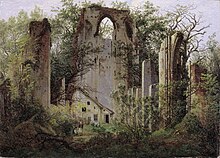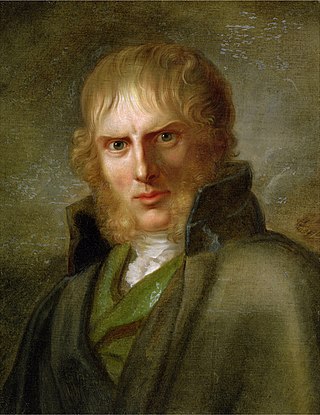
Caspar David Friedrich was a German Romantic landscape painter, generally considered the most important German artist of his generation, whose often symbolic, and anti-classical work, conveys a subjective, emotional response to the natural world. Friedrich's paintings often set contemplative human figures silhouetted against night skies, morning mists, barren trees or Gothic ruins. Art historian Christopher John Murray described their presence, in diminished perspective, amid expansive landscapes, as reducing the figures to a scale that directs "the viewer's gaze towards their metaphysical dimension".

Eldena Abbey, originally Hilda Abbey is a former Cistercian monastery near the present town of Greifswald in Mecklenburg-Vorpommern, Germany. Only ruins survive, which are well known as a frequent subject of Caspar David Friedrich's paintings, including the famous Abtei im Eichwald.

The Stages of Life is an allegorical oil painting of 1835 by the German Romantic landscape painter Caspar David Friedrich. Completed just five years before his death, this picture, like many of his works, forms a meditation both on his own mortality and on the transience of life.
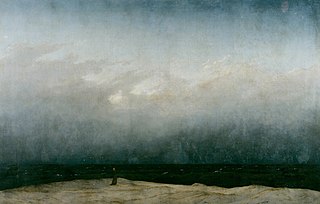
The Monk by the Sea is an oil painting by the German Romantic artist Caspar David Friedrich. It was painted between 1808 and 1810 in Dresden and was first shown together with the painting The Abbey in the Oakwood in the Berlin Academy exhibition of 1810. On Friedrich's request The Monk by the Sea was hung above The Abbey in the Oakwood. After the exhibition, both pictures were bought by king Frederick Wilhelm III for his collection. Today, the paintings hang side by side in the Alte Nationalgalerie, Berlin.
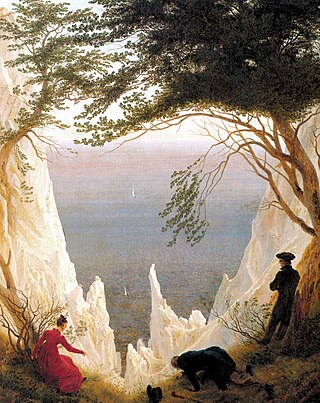
Chalk Cliffs on Rügen is an oil painting of circa 1818 by German Romantic artist Caspar David Friedrich.

The Tree of Crows is an oil painting by the German Romantic artist Caspar David Friedrich, from 1822. Acquired by the Louvre in 1975, it has been called one of Friedrich's "most compelling paintings." The painting depicts a twisted oak tree, bare but for a few dead leaves, seen against an evening sky. An inscription on the back of the canvas refers to the hill at the painting's center as a Hünengrab, or dolmen, a prehistoric burial ground. In the distance can be seen the ocean, and Cape Arkona's chalk cliffs, a favorite subject of Friedrich's. Two crows are perched on the oak, while a flock descends toward it. In the darkened foreground are a hacked trunk and the upright stump of another oak.

Two Men Contemplating the Moon and Man and Woman Contemplating the Moon are a series of similar paintings by Caspar David Friedrich, the setting being among his best-known works. Friedrich painted at least three versions, with one variation featuring a man and a woman. The 1819–20 version in the Galerie Neue Meister is thought to be the original; the c. 1824 variant with a woman is in the Alte Nationalgalerie; and the c. 1830 version is in the Metropolitan Museum of Art.
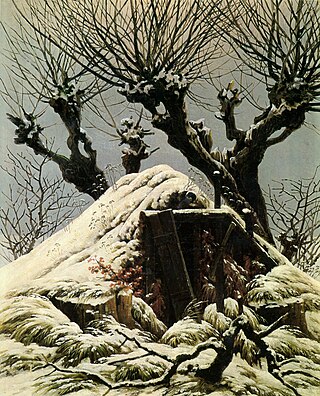
Cabin in the Snow or Cabin under Snow is an 1827 painting by Caspar David Friedrich, first exhibited at the exhibition held by the Dresden Academy of Fine Arts, from which it was acquired by John I of Saxony.

Two Men by the Sea is a painting by Caspar David Friedrich, first exhibited at the exhibition held by the Dresden Academy of Fine Arts in 1817, from which it was acquired a representative of mother superior Maria Richter of Berlin. It first appears in the inventories of the Nationalgalerie in 1936 as number A II 884. It was displayed at the Schloss Charlottenburg until 1967 and from 1986 to 2001 it was hung in the Schloss' Knobelsdorff wing. Since 2001 it has been displayed in the Alte Nationalgalerie in Berlin.

The Watzmann is an 1824-1825 oil on canvas painting by Caspar David Friedrich, showing the Watzmann mountain as seen from Berchtesgaden to the north-east. It is now on display in the Alte Nationalgalerie in Berlin.
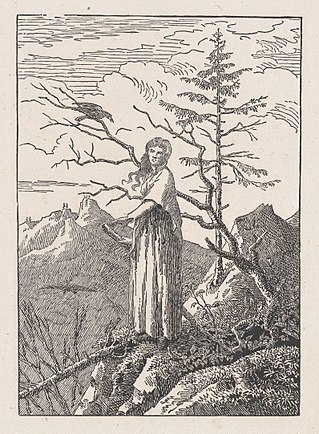
Woman with a Raven at an Abyss is a c. 1803/04 print by the German Romantic painter Caspar David Friedrich, made into a woodcut by his brother Christian Friedrich, a carpenter and furniture maker, around the same time.

Evening is an 1821 oil on canvas painting by Caspar David Friedrich, now in the Niedersächsischen Landesmuseum Hannover. With Morning, Midday and Afternoon, it forms a series on different times of day.

River Bank in Fog is a c. 1821 oil on canvas painting by Caspar David Friedrich, now in the Wallraf-Richartz-Museum & Fondation Corboud in Cologne, for which it was acquired in 1942 from the Graf Hahn collection at Schloss Basedow (Mecklenburg). It is also known as Elbschiff in Early Fog.

The Gazebo or The Garden Bower is an 1818 oil on canvas painting by Caspar David Friedrich, now in the Neue Pinakothek, in Munich.

Neubrandenburg or Neubrandenburg in the Morning Mist is an oil on canvas painting by Caspar David Friedrich, executed c. 1816, now in the Pomeranian State Museum in Griefswald. The artist's parents were both born in Neubrandenburg and he often painted it - another example is Neubrandenburg Burning.

The Tombs of the Old Heroes is an oil-on-canvas painting by the German Romantic artist Caspar David Friedrich, painted between April and August 1812. It is also known as The Graves of the Fallen Freedom Fighters or Arminius's Grave and is now in the Hamburger Kunsthalle.

The Great Enclosure or The Ostra Enclosure (Ostra-Gehege) is an 1831 oil-on-canvas painting by Caspar David Friedrich, now in the collection of the Albertinum of the Galerie Neue Meister, in Dresden.

Hutten's Grave (1823) is an oil on canvas painting by Caspar David Friedrich, showing a man in Lützow Free Corps uniform standing by the grave of the Renaissance humanist and German nationalist Ulrich von Hutten. Influenced heavily by the political climate of the time and Friedrich's own political beliefs, the painting is one of Friedrich's most political works and affirms his allegiance to the German nationalist movement. The painting was made to commemorate the 300th anniversary of Hutten's death and the 10th anniversary of Napoleon's invasion of Germany. It is now in the Klassik Stiftung Weimar's collection and on show in the Schlossmuseum at the Stadtschloss Weimar.

The Temple of Juno in Agrigento is an 1828-1830 oil on canvas painting of by Caspar David Friedrich. It is now in the Museum für Kunst und Kulturgeschichte, in Dortmund, which bought it from a Cologne art dealer in 1951. It is said to have been previously owned by the F. A. Brockhaus publishers in Leipzig.
Jens Christian Jensen was a German art historian and curator.

